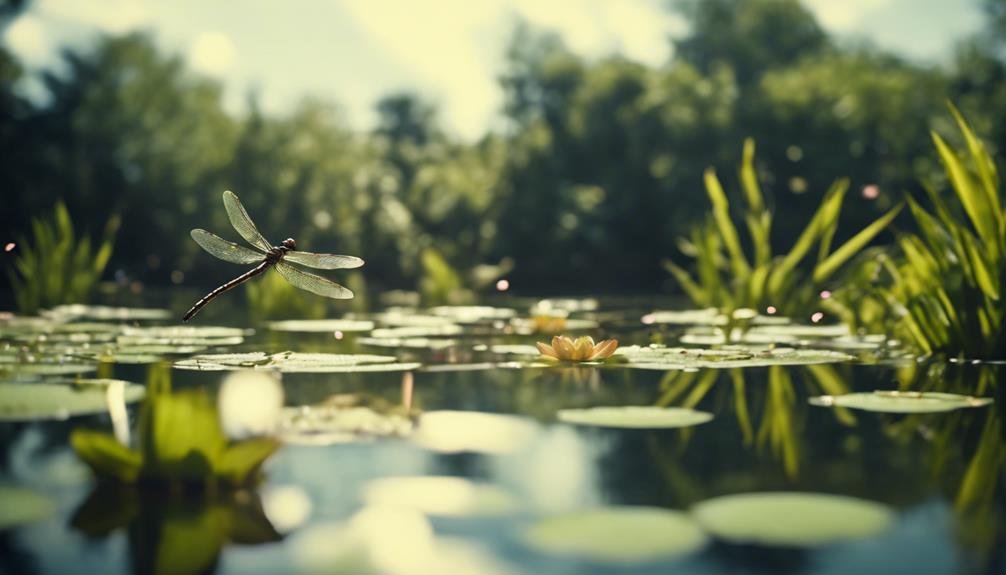Incorporating native plants into ponds offers many benefits. These locally adapted species require minimal maintenance as they naturally resist pests and diseases. They play a crucial role in restoring ecological balance by providing food and shelter, attracting native wildlife to create a diverse and self-sustaining habitat.
Some of the links in this article may be affiliate links. If you make a purchase through these links, we may earn a small commission at no extra cost to you. Thank you.
Native aquatic plants enhance the pond's beauty year-round with their vibrant colors and textures. Their unique adaptations enable them to coexist seamlessly within the local environment. By using these resilient and low-maintenance plants, you can transform your pond into a thriving ecosystem that supports biodiversity and sustainability.
Low Maintenance Requirements
Using native plants in ponds offers the advantage of low maintenance requirements. These plants are well-suited to our local climate and soil, thriving with minimal care. They don't need special fertilizers or constant attention like non-native species do. Once native plants are established, they can largely take care of themselves, requiring little intervention.
Moreover, native plants naturally resist many local pests and diseases, reducing the need for chemical treatments. Their strong root systems also help prevent erosion, reducing the effort needed to maintain pond banks.
Ecological Balance Restoration
Introducing native plants into ponds is essential for restoring ecological balance disrupted by invasive species. By incorporating these plants, we can create habitats that mimic natural ecosystems and attract native wildlife, promoting biodiversity.
Imagine a scene where dragonflies and damselflies flutter over vibrant water lilies, frogs croak from the shelter of cattails and rushes, schools of minnows dart through submerged aquatic plants, and butterflies flit among colorful blooms of pickerelweed and arrowhead.
Native plants not only enhance the aesthetic appeal but also provide food and shelter for various species, fostering a thriving ecosystem. Moreover, they play a crucial role in regulating water quality by absorbing excess nutrients and filtering out pollutants.
Natural Beauty Enhancement

Native pond plants not only restore ecological balance but also enhance the beauty of backyard water features. These indigenous species have evolved to thrive in our local ecosystems, offering a variety of colors, textures, and growth patterns that complement the surroundings.
From vibrant blooms to graceful underwater foliage, native aquatic plants create visually appealing scenes that bring a sense of tranquility to our outdoor spaces.
One of the key benefits of using native pond plants is the year-round interest they provide. In spring, delicate blossoms and fresh greenery emerge, while summer brings lush foliage. As autumn arrives, these plants showcase brilliant hues, and even in winter, their architectural remnants and intriguing silhouettes add to the beauty of the pond.
Wildlife Habitat Provision
Imagine a pond bustling with life, thanks to the presence of native aquatic plants. These plants not only enhance the beauty of the water feature but also create a thriving ecosystem for wildlife. Picture dragonflies gracefully perched on water lily leaves, frogs finding shelter among the reeds while adding a soothing croak to the ambiance, and butterflies flitting from one blossom to another for nectar. Schools of fish dart through the underwater foliage, seeking refuge and sustenance.
Native pond plants play a crucial role in providing food, nesting materials, and hiding spots for various creatures. By incorporating these indigenous species into our water features, we mimic nature's design and promote biodiversity in a self-regulating environment that requires minimal maintenance. These plants are well-suited to local conditions, making them resilient and easy to care for.
With thoughtful planning, our ponds can transform into vibrant sanctuaries teeming with life.
Local Adaptation Benefits

Using locally adapted plants in our ponds offers numerous benefits due to their natural suitability for the region's climate and soil conditions. These plants have evolved to thrive in our specific environmental factors like temperature, rainfall, and soil composition. By incorporating these well-adapted species, we can establish a low-maintenance, sustainable ecosystem that requires minimal intervention and resources.
Native plants are less likely to disrupt the local ecosystem or become invasive. They coexist harmoniously with indigenous wildlife, providing food and shelter for various species of birds, insects, and aquatic creatures. This symbiotic relationship promotes biodiversity and supports the overall health of the pond environment.
Moreover, locally adapted plants often have unique adaptations that enhance their resilience to local pests and diseases. These natural defenses reduce the need for chemical treatments, making our ponds more environmentally friendly and cost-effective to maintain in the long run.
Conclusion
Introducing native plants into our ponds not only enhances the beauty of our surroundings but also supports the local wildlife, creating a thriving ecosystem. These plants are well-adapted to the environment, requiring little maintenance while contributing to the overall balance of the ecosystem. Their presence not only adds to the visual appeal of our waterscapes but also promotes sustainability by preserving the natural harmony of the area.
Native plants play a crucial role in maintaining the ecological balance of ponds by providing habitats and food for various species of wildlife, such as birds, insects, and amphibians. For example, plants like Pickerelweed (Pontederia cordata) and Arrow Arum (Peltandra virginica) not only add beauty to the pond but also offer shelter and food for fish and other aquatic creatures. By choosing native plants, we can create a self-sustaining environment that thrives with minimal human intervention.
In essence, incorporating native plants into our ponds is a simple yet impactful way to support biodiversity and create a more sustainable ecosystem. These plants not only enhance the visual appeal of our waterscapes but also contribute to the overall health and balance of the pond. By embracing native species, we can enjoy a beautiful and thriving aquatic environment that benefits both wildlife and our own well-being.

